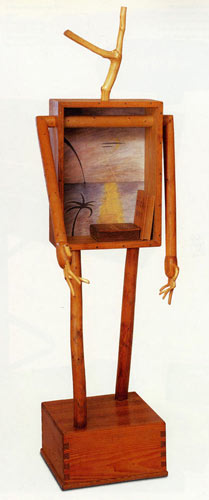
This funky, fun show highlights work by two highly accomplished and similarly offbeat artists, William T. Wiley and H.C. Westermann. Wiley is one of the founders of the West Coast Funk movement and a masterful watercolorist, and Westermann is known for his inventive child-art or “low brow” aesthetic ,with doses of Surrealism. Make no mistake, this is finely crafted work, a fact particularly discernable in his sculpture. Of particular note is the use of unusual materials.
The two are linked art-historically for their 1960s and ‘70s fine-art counterculture ways. Specifically, the artists turned away from mainstream art trends, be it minimalism or Abstract Expressionism. The two are also linked on more personal terms. Wiley (the younger of the two) was influenced by Westermann’s work; a mutual admiration developed over the artists’ years-long friendship and correspondence.
Common to both artists’ works are handwritten words and phrases, including a generous spattering of puns and sarcasm. The text reinforces the message, as well as the humor. There are also nods to art history. The works are highly personal and often emotional, making them truly individualistic.
Examples on view here show both artists at their best. From Westermann we see work spanning 1969 to 1980 (the artist passed in 1981), and from Wiley, mostly recent works, from 2009 and 2010. The quirky cartoonish, outsider-art appearance of these pieces belies their thinly veiled sophistication. It doesn’t take much more than a short pause to uncover the layers and rich storylines embedded in the pieces.
The subjects addressed are often weighty, including war, a major focus of Westermann’s, resulting from his personal experience serving in World War II. “Death Black Ship” (1972) — the ship is a recurring icon in Westermann’s work — is a wonderful example of such conflict-focused work. A battle rages off to one side, colorful and full of movement, while in the foreground, two rats sit on a ship’s deck with the quote, “Spectre though I may be, I am not sent to scare thee or deceive, But in reward of thy fidelity,” along with the attribution to Wordsworth, just off to their left. The sculpture “Death Ship of No Port with a List” (1969) demonstrates Westermann’s fine skill as a woodworker, while “The Deerslayer” (1969) shows off his use of odd materials — it’s a figure made of metal pipe with a head of deer horns — and ironic humor.
Wiley’s pieces examine variously our deteriorating environment, Eastern philosophy, wisdom (or lack thereof), social inequities, and an array of social-political subjects. The dunce cap features prominently in several of the works. It serves as a symbol of expression regarding the idiocies around us. For instance, in “Dunce One” (2009) — from a series of four works, each of which features one yellow cap decorated with words (and a lot of word play), phrases, and random imagery — features the phrase, “seems like it would be better to pay people to be good/cheaper than not helping them.” Not to be overshadowed by the abundance of text in most of these works is, indeed, Wiley’s talent as a painter; of particular note here are the pieces “True Safety” (2009) and “Is This Double Dip Exression” (2010).
Though very much about their time, this pair of artists, their work imbued with humanity, will and do endure (John Berggruen Gallery, San Francisco, California).
